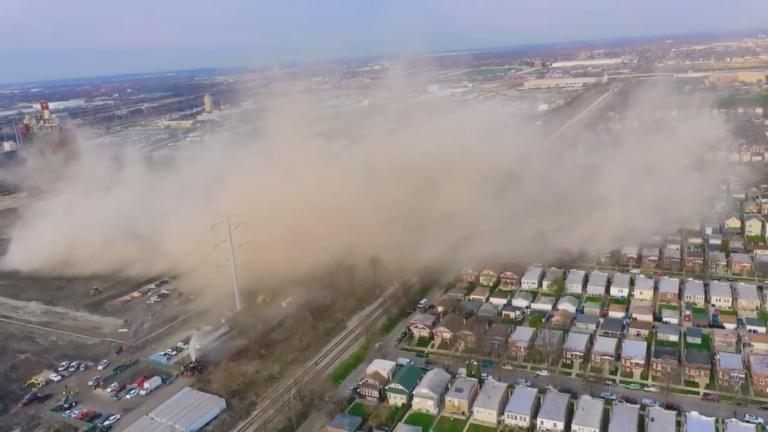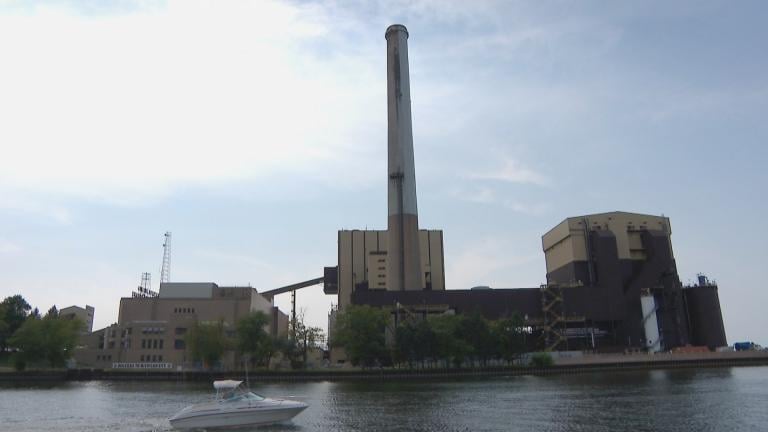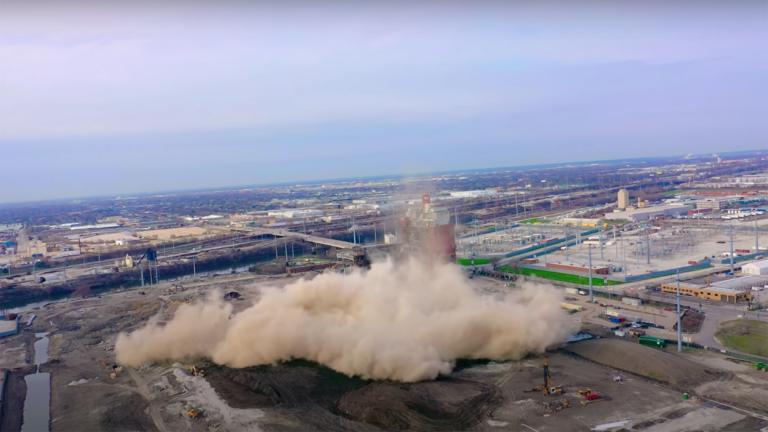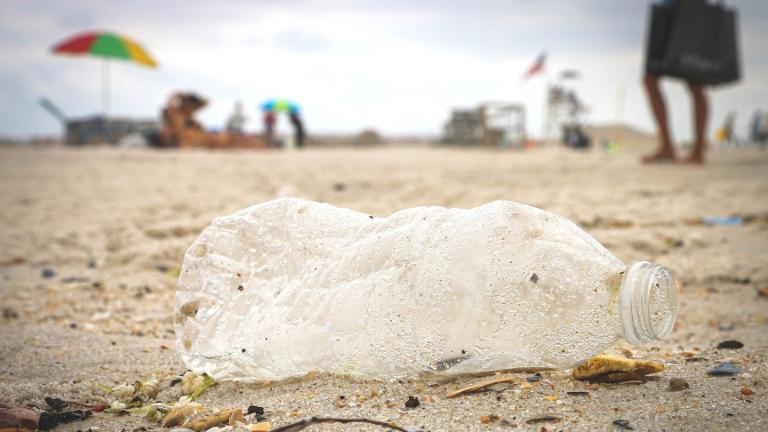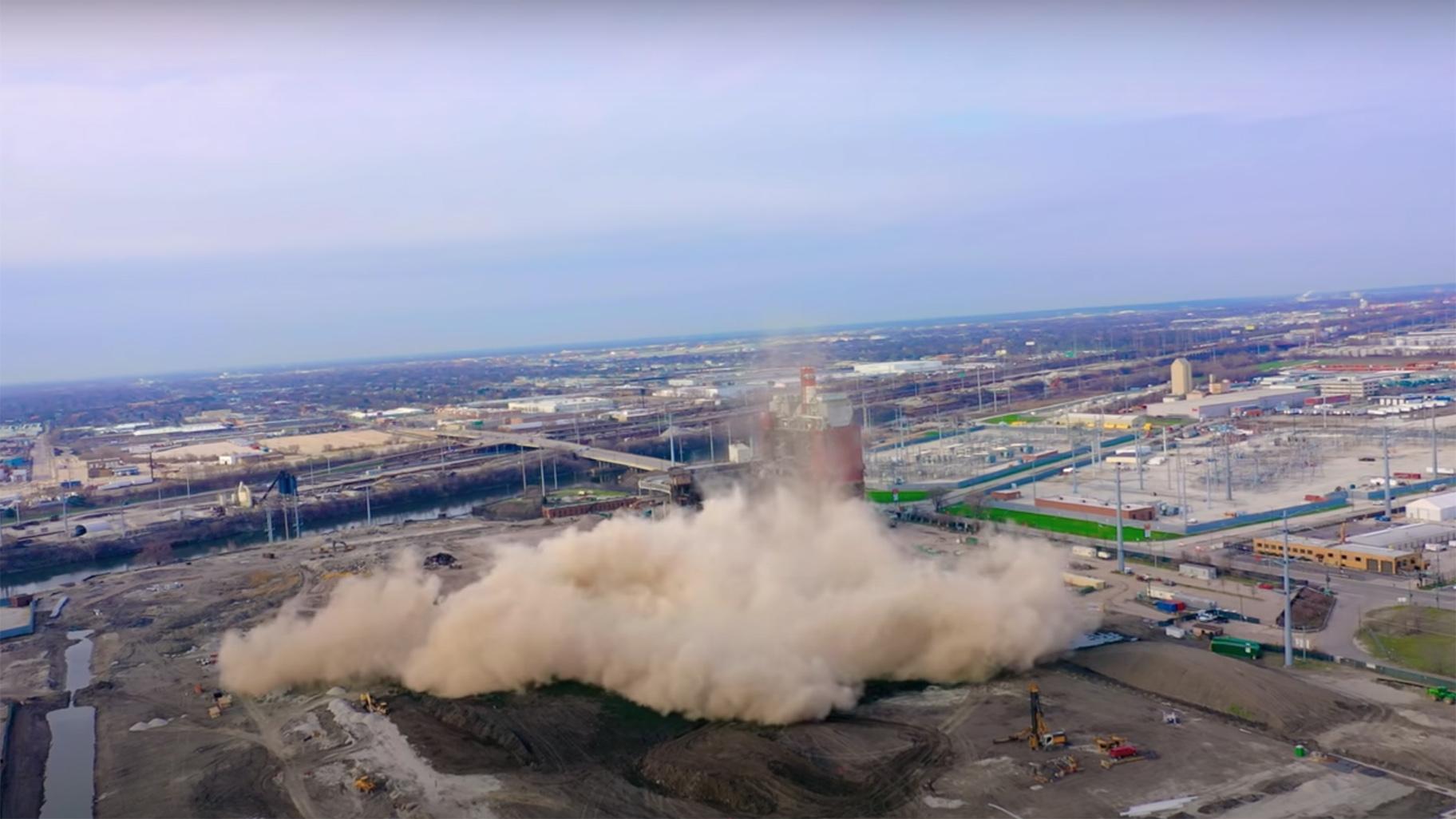 A still image from a video taken of the demolition of the Crawford Coal Plant smokestack, April 11, 2020. (Alejandro Reyes / YouTube)
A still image from a video taken of the demolition of the Crawford Coal Plant smokestack, April 11, 2020. (Alejandro Reyes / YouTube)
Chicagoans enveloped in the dust that blanketed much of Little Village in the early morning hours of April 11, 2020, after the botched implosion of the smokestack at the Crawford Power Plant face a Tuesday deadline to submit a claim for a portion of a $12.25 million class action lawsuit.
Edith Tovar, of the Little Village Environmental Justice Organization, said her organization expects approximately 130,000 people submit a claim for damages. Many who turned to the community group for help submitting their claims said they and their families had been plagued by respiratory illnesses since the implosion, Tovar added.
“It was difficult to listen to these stories,” Tovar said.
Many of those who have their claims approved will likely get no more than $500, according to the lawyers who brought the suit on behalf of those who live and work in Little Village between 33rd Street and Kedzie Avenue west to Kilbourn Avenue, north to Cermak Road, east to Ogden Avenue, northeast to California Avenue, south to 26th Street, west to Sacramento Avenue, south to 31st Street, west to Kedzie Avenue, and south to 33rd Street.
“That’s such a low amount of money compared to the lasting impact of the implosion,” Tovar said.
Claims can be filed online at littlevillagesmokestack.com.
Below is a map of the geographic area included in the settlement.
When demolition crews used explosives to bring down the smokestack at the defunct coal power plant, near 33rd Street and Pulaski Road, a plume of dust coated six blocks of homes in Little Village just as the COVID-19 pandemic was beginning to slam Chicago.
City officials with the Department of Buildings should have required the firms doing the work to get a new permit that allowed them to use explosives, according to a confidential report by the city’s watchdog obtained by WTTW News.
In addition, city health officials were warned 213 days before the demolition that the “dust from an event like this is almost cataclysmic,” according to the watchdog’s probe. Fifty-one days before the demolition, health officials were told that dust would be “an unpreventable byproduct” of the operation, according to the report.
Former Mayor Lori Lightfoot rejected former Inspector General Joseph Ferguson’s recommendation to fire Dave Graham, who was then an assistant commissioner in the Chicago Department of Public Health.
In October 2023, under Mayor Brandon Johnson, Graham was promoted to director of environmental health and safety compliance for the department. Graham is responsible for managing the health department’s environmental inspections and enforcement.
Lightfoot also rejected Ferguson’s recommendation to discipline Marlene Hopkins, who was the top official from the city’s Buildings Department charged with overseeing the implosion of the smokestack at the former Crawford Power Plant in Little Village.
Johnson nominated Hopkins to lead the Buildings Department earlier this month. She must be confirmed by the Chicago City Council.
It has been difficult for people who endured the botched implosion to see the people who greenlighted it be promoted, Tovar said.
“It is disrespectful,” Tovar said. “We have never had a chance to heal. April 11 was an environmental disaster that could have been prevented.”
Three firms involved in the implosion of the smokestack at the former Crawford Power Plant paid $370,000 to settle a lawsuit filed by Illinois Attorney General Kwame Raoul. In addition, city officials hit Hilco and two other firms involved in the implosion with 16 citations, which officials told the news media came with $68,000 in fines.
Hilco paid $19,500 to resolve five citations, according to city records.
Two other firms — MCM Management and Controlled Demolition Inc. — each paid an additional $17,000 to resolve citations related to the implosion.
The renewed focus on the implosion comes just a few weeks before the fourth anniversary of the implosion. The Little Village Environmental Justice Organization is planning several events, including a community altar, Tovar said.
The implosion prompted the Chicago City Council to adopt new laws and regulations on its books designed to improve the quality of air on Chicago’s South and West sides, which is significantly more polluted than the air in wealthier neighborhoods, data shows.
However, Johnson has yet to fulfill his campaign promise to ask the City Council to approve what he calls the Cumulative Impact Assessment Ordinance, which would allow the city to take into account the amount of existing air, water and soil pollution in a community – not just what the proposed project is expected to add if it is approved – when considering allowing additional polluting industries.
Johnson campaigned on a platform that promised to put an end to what he called “literal sacrifice zones” – neighborhoods home to Black and Latino Chicagoans where industrial firms are allowed to pollute the air, water and soil with impunity, making residents sick and degrading their quality of life.
That ordinance will be based on an assessment the city was ordered to complete under the terms of an agreement reached by former Mayor Lori Lightfoot with the U.S. Department of Housing and Urban Development. That agreement required the city to stop allowing industrial businesses to continue to pollute the already dirty air, water and soil on Chicago’s South and West sides.
Ald. Maria Hadden (49th Ward), the chair of the Environmental Protection and Energy Committee, said she hoped to advance the measure sometime this summer.
Contact Heather Cherone: @HeatherCherone | (773) 569-1863 | [email protected]

